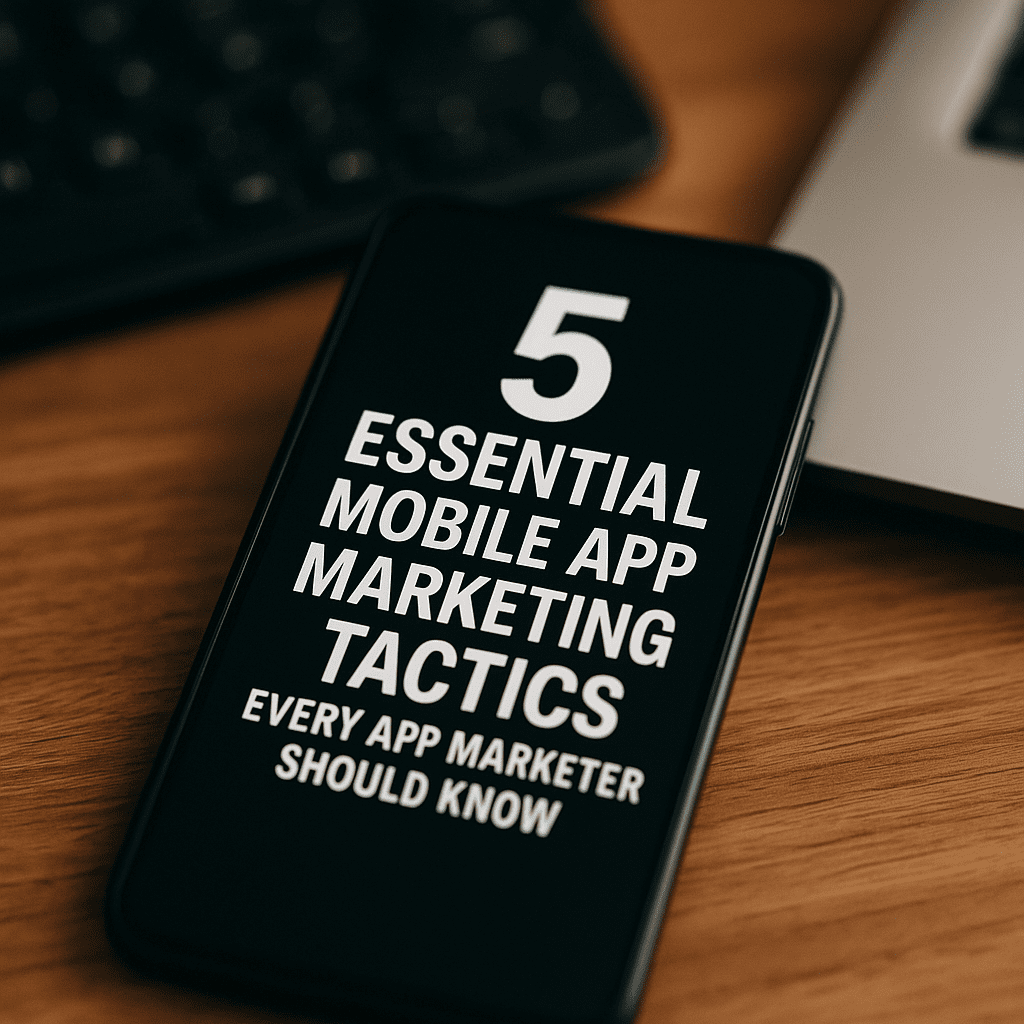
5 Essential Mobile App Marketing Tactics Every App Marketer Should Know
In today’s hyper-competitive digital landscape, even the most innovative applications can disappear without a trace if they lack a strong marketing engine. As we head further into 2025, mobile app marketing demands more than just downloads—it requires a holistic strategy that carries potential users from first awareness to long-term loyalty.
From optimizing your presence in app stores to fostering engaged communities, this guide breaks down the five cornerstone tactics every app marketer should master. Implement these proven approaches, backed by data and real-world examples, to build a self-reinforcing growth flywheel for your application.
1. App Store Optimization (ASO): Your Foundation for Sustainable Growth
App Store Optimization (ASO) remains the pillar of organic user acquisition. Just as SEO drives website visibility, a well-executed ASO plan ensures your app surfaces for relevant searches in the Apple App Store, Google Play, and alternative marketplaces.
Key Components of an Effective ASO Strategy
- Keyword Research: Map high-volume, low-competition terms that align with your core features. Tools like AppTweak and Sensor Tower can uncover hidden keyword opportunities.
- Compelling Visual Assets: Use high-resolution screenshots and preview videos to highlight your app’s unique value. Showcase core features in context, not just UI screens.
- Ratings and Reviews: Encourage satisfied users to leave feedback. A 4.5-star average can boost conversions by up to 20%. Respond to critical reviews to demonstrate commitment to improvement.
- Regular Updates: Frequent releases signal ongoing development. Highlight new features in your “What’s New” section to keep users and algorithms engaged.
ASO is never “set and forget.” Schedule monthly audits of your metadata, A/B test alternate icons, and monitor keyword rankings. By dedicating 10–15% of your marketing budget to ASO and continuous creative testing, you can unlock a reliable channel for organic growth that complements paid efforts.
Learn more about implementing effective ASO strategies to maximize visibility and drive higher conversion rates.
2. Multi-Channel User Acquisition Campaigns
Diversifying acquisition channels is critical to mitigate rising costs and evolving platform policies. In 2025, top app marketers run coordinated campaigns across paid search, social media, programmatic, and in-app networks.
Paid User Acquisition
- Search Ads: Target high-intent queries like “best fitness tracking app” to capture users further down the funnel.
- Social Media Ads: Leverage lookalike audiences on Facebook and Instagram, or Interest-based targeting on TikTok. Video ads should hook viewers in the first 3 seconds.
- Programmatic & In-App Networks: Use SDKs from networks like Unity Ads or IronSource to reach niche audiences within relevant apps.
Always set clear KPIs—Cost Per Install (CPI), Return on Ad Spend (ROAS), and Lifetime Value (LTV). Use predictive LTV models to bid aggressively on high-value segments, then reinvest profits to scale efficiently.
Social Media Marketing
Each platform demands a tailored approach:
- TikTok: Short, authentic clips demonstrating real-life use cases.
- Instagram: Carousel ads and Stories with shoppable links or “Swipe Up” CTAs.
- LinkedIn: Whitepapers, case studies, and professional testimonials for B2B or productivity apps.
Focus on building a two-way conversation. Host weekly AMAs, share behind-the-scenes development posts, and highlight user stories to humanize your brand and foster trust.
Discover how to craft platform-specific social media strategies that resonate with your ideal audience and drive sustainable installs.
3. Implement a Robust Retention Strategy
Acquisition without retention is like filling a leaky bucket. In 2025, leading app marketers invest as heavily in keeping users as they do in acquiring them. A strong retention plan boosts average session length, drives in-app purchases, and increases referral rates.
Personalization & User Segmentation
Leverage behavioral data—first-time actions, frequency, and in-app purchases—to segment users into cohorts. Then deliver targeted messages, feature recommendations, and special offers. Personalized push notifications can lift retention by up to 40% when timed correctly.
Gamification Elements
Implement progress bars, points, badges, and streaks to tap into intrinsic motivation. For example, a language-learning app that rewards daily practice with badges saw a 30% increase in 7-day retention after adding a streak feature.
Exceptional Customer Service
Offer in-app chat support, a detailed FAQ section, and a responsive social media presence. Rapid, empathetic responses not only resolve issues but also reinforce your brand’s commitment to user satisfaction.
Explore in-app marketing strategies that boost retention and revenue through contextual engagement.
4. Leverage Email Marketing and Push Notifications
Despite new channels like chatbots and conversational AI, email marketing remains a cornerstone for nurturing leads and re-engaging dormant users. Pair email with strategic push notifications to build a continuous engagement loop.
Growing Your Email List
- In-App Signup Prompts: Trigger at high-value moments, such as account creation or feature breakthroughs.
- Website Pop-Ups & Landing Pages: Offer exclusive tips or in-app credits in exchange for an email address.
- Social Conversion: Promote gated content or webinars on your social channels.
Designing an Engagement Loop
Use behavioral triggers to send the right message at the perfect time:
- Abandoned Onboarding: Remind users who stopped during setup.
- Feature Unlock: Notify users when they achieve a milestone or unlock new functionality.
- Re-Engagement: Offer a special promo or content recap to lapsed users after 7 days of inactivity.
Learn about push notification best practices that keep users engaged without overwhelming them.
5. Build a Referral and Community Ecosystem
Word-of-mouth remains the most cost-effective acquisition channel. By cultivating advocates and empowering user-generated content, you can catalyze organic growth and turn users into brand ambassadors.
Referral Marketing Programs
Design double-sided incentives—reward both the referrer and the referee. Examples include in-app currency, premium feature trials, or exclusive badges. Leading lifestyle apps report a 15–25% uplift in installs from referral channels when incentives are well aligned.
User-Generated Content
Encourage users to share their success stories, tutorials, and creative applications of your app. Create a hashtag campaign, then feature the best submissions in your social media highlights or newsletters. Authentic content builds trust faster than any paid ad.
Community Building Features
- Discussion Forums: Allow users to ask questions, share tips, and troubleshoot together.
- User Groups: Organize by interest, location, or skill level to deepen engagement.
- Collaborative Tools: Enable co-editing, challenge modes, or team-based features to increase network effects.
Discover strategies for building engaged app communities that drive organic growth and long-term retention.
Implementing Your Mobile App Marketing Action Plan
Tactics alone won’t deliver results without a clear roadmap. Use this 180-day framework to transform your marketing flywheel from concept to scale:
First 30 Days
- Set up analytics (GA4, Firebase, Adjust) and define core KPIs.
- Conduct an ASO audit: refresh metadata, visual assets, and review cadence.
- Optimize first-time user experience (FTUE) for maximum engagement.
- Implement basic push notification workflows.
- Create a reporting dashboard for downloads, DAU/WAU/MAU, CPI, and ROAS.
Days 31–90
- Run initial paid acquisition tests across 2–3 primary channels.
- Launch segmentation-based retention campaigns (email, push).
- Start A/B tests on app store creatives and in-app UI elements.
- Develop a content calendar for social media and community posts.
- Build referral program MVP and early promos.
Days 91–180
- Scale winning acquisition channels, allocate budget to top performers.
- Implement advanced personalization and in-app recommendations.
- Explore partnerships with complementary apps and alternative stores.
- Expand referral incentives and gamification across user segments.
- Refine LTV modeling and optimize ROAS to maximize profitability.
Conclusion: Building a Sustainable Growth Engine
The most successful mobile app marketing strategies in 2025 integrate the five tactics—ASO, multi-channel acquisition, retention, strategic communication, and community—into a cohesive growth engine. By delivering value at every touchpoint, you’ll not only attract users but transform them into advocates who amplify your efforts.
For a concrete example of how these tactics come together, see A success story visualization highlighting how mobile app marketing transformed performance for a struggling app, with key metrics and milestones. Use this blueprint to adapt, test continuously, and build genuine connections with your audience.
Start implementing these strategies today to position your app for sustained success in 2025 and beyond. Contact app marketing experts to develop a customized plan that aligns with your goals and drives measurable results.
